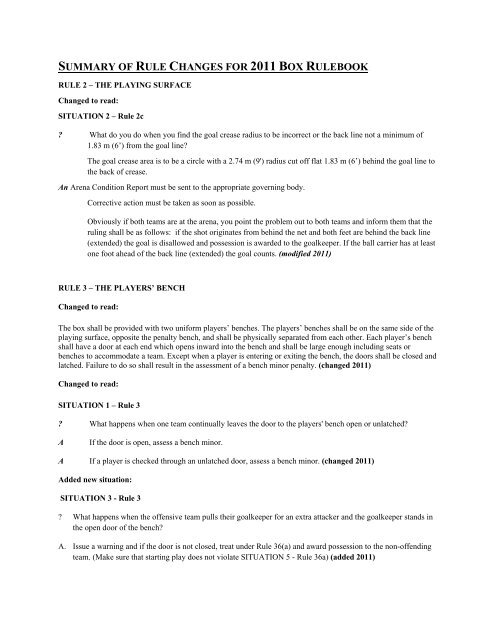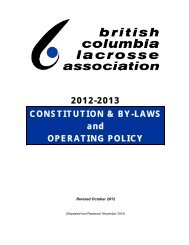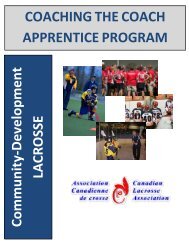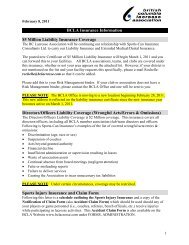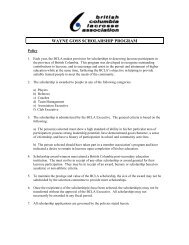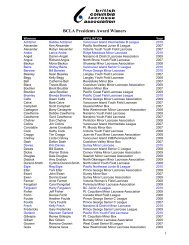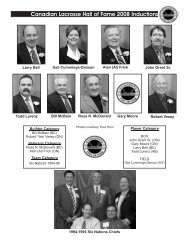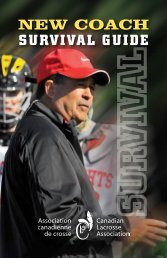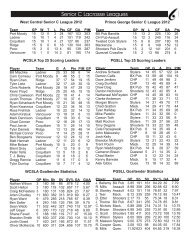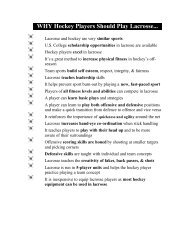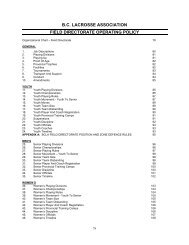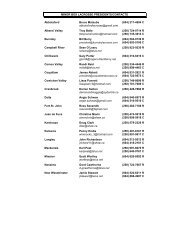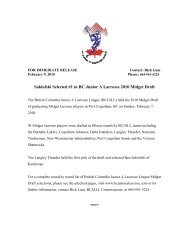Box Rulebook Changes - Canadian Lacrosse Association
Box Rulebook Changes - Canadian Lacrosse Association
Box Rulebook Changes - Canadian Lacrosse Association
You also want an ePaper? Increase the reach of your titles
YUMPU automatically turns print PDFs into web optimized ePapers that Google loves.
SUMMARY OF RULE CHANGES FOR 2011 BOX RULEBOOK<br />
RULE 2 – THE PLAYING SURFACE<br />
Changed to read:<br />
SITUATION 2 – Rule 2c<br />
? What do you do when you find the goal crease radius to be incorrect or the back line not a minimum of<br />
1.83 m (6’) from the goal line?<br />
The goal crease area is to be a circle with a 2.74 m (9') radius cut off flat 1.83 m (6’) behind the goal line to<br />
the back of crease.<br />
An Arena Condition Report must be sent to the appropriate governing body.<br />
Corrective action must be taken as soon as possible.<br />
Obviously if both teams are at the arena, you point the problem out to both teams and inform them that the<br />
ruling shall be as follows: if the shot originates from behind the net and both feet are behind the back line<br />
(extended) the goal is disallowed and possession is awarded to the goalkeeper. If the ball carrier has at least<br />
one foot ahead of the back line (extended) the goal counts. (modified 2011)<br />
RULE 3 – THE PLAYERS’ BENCH<br />
Changed to read:<br />
The box shall be provided with two uniform players’ benches. The players’ benches shall be on the same side of the<br />
playing surface, opposite the penalty bench, and shall be physically separated from each other. Each player’s bench<br />
shall have a door at each end which opens inward into the bench and shall be large enough including seats or<br />
benches to accommodate a team. Except when a player is entering or exiting the bench, the doors shall be closed and<br />
latched. Failure to do so shall result in the assessment of a bench minor penalty. (changed 2011)<br />
Changed to read:<br />
SITUATION 1 – Rule 3<br />
? What happens when one team continually leaves the door to the players' bench open or unlatched?<br />
A If the door is open, assess a bench minor.<br />
A If a player is checked through an unlatched door, assess a bench minor. (changed 2011)<br />
Added new situation:<br />
SITUATION 3 - Rule 3<br />
? What happens when the offensive team pulls their goalkeeper for an extra attacker and the goalkeeper stands in<br />
the open door of the bench?<br />
A. Issue a warning and if the door is not closed, treat under Rule 36(a) and award possession to the non-offending<br />
team. (Make sure that starting play does not violate SITUATION 5 - Rule 36a) (added 2011)
RULE 8 – THE GOALS<br />
(a) Each goal shall consist of two upright poles, 1.22 m (4’) apart, joined by a rigid crossbar 1.22 m (4’) from<br />
the playing surface. All measurements are to be inside distances. The poles and crossbar shall be fitted with<br />
a cone shape netting of not more than 3.81cm (1.5”) mesh, fastened to the playing surface at a point 1.22m<br />
(4’) behind the centre of the goal line. The mesh shall not be drawn taut.<br />
NOTE 1 is deleted. Tyke goals are now in an appendix<br />
Note 2 is changed to read:<br />
NOTE: In Junior B, Junior A, and Senior B, each goal shall consist of two upright poles, 1.37 m (4’6")<br />
apart, joined by a rigid crossbar 1.22m (4') from the playing surface. All measurements are to be inside<br />
distances. (changed 2011)<br />
(b) The nominal diameter of the goal posts and crossbar shall be 5.08 cm (2") and they shall be painted red.<br />
(changed 2011)<br />
RULE 11 – HEADWEAR<br />
Changed to read:<br />
(b) (i) All helmets shall meet NOCSAE or CSA approval with a chinstrap that is properly secured<br />
during play. Any player (other than the ball-carrier) whose helmet becomes dislodged, must immediately<br />
remove themselves completely from active play until they put on and secure their helmet. If a ball-carrier’s<br />
helmet/chinstrap becomes dislodged the play shall stop immediately. If no penalty occurs there will be a<br />
loss of possession and the player shall leave the surface immediately. Any infraction of this section shall<br />
result in a minor penalty. (changed 2011)<br />
Changed to read:<br />
SITUATION 2 – Rule 11b<br />
? Does a player who has lost his/her helmet and has a breakaway have to pass or shoot immediately?<br />
A NO. Play is stopped immediately and the player must leave the surface and be replaced. There is a<br />
loss of possession unless a penalty is to be called on the stoppage. The 30-second clock will reset.<br />
(changed 2011)<br />
? What should you do if the goalkeeper's helmet becomes dislodged?<br />
A Anytime the defensive goalkeeper's mask or helmet becomes dislodged or comes off, stop play<br />
immediately. If the attacking team has possession, restart play with possession to that team. In all<br />
other cases restart play with a face-off. If this is intentional by the goalkeeper, assess a minor<br />
penalty. If a Goalkeeper on the floor intentionally removes any of his/her protective equipment<br />
while an opposing player is on a breakaway, award a penalty shot and assess a Gross misconduct.<br />
(The minor penalty would be nullified by the penalty shot).
RULE 17 – NON-PLAYING PERSONNEL<br />
Changed to read:<br />
(a) Only players in uniform, the coaches and trainer who are suitably attired, shall be permitted on the players’<br />
bench. A maximum of six non-playing personnel shall be allowed on the players’ bench (changed 2011).<br />
Changed to read:<br />
SITUATION 1 – Rule 17a<br />
? What does "Suitably attired" mean?<br />
A Suitably attired means that all players including the substitute designated goalkeeper must wear an<br />
approved helmet/mask while on the players’ bench. The penalty shall be a ten-minute misconduct as per<br />
Rule 11 Situation 1 (modified 2011)<br />
RULE 36 – CHANGE OF PLAYERS/TOO MANY PLAYERS<br />
Changed to read:<br />
SITUATION 2 – Rule 36a<br />
?<br />
A player is at the bench for the purpose of substitution<br />
A<br />
a) and is inadvertently struck by the ball while having no intent of playing<br />
the ball. If his/her substitute is on the floor, should this be penalized?<br />
What happens if player A1 (at the players’ bench) is obviously on<br />
a) No.<br />
b) his/her way to the players’ bench for substitution. Player B1<br />
b) Assess B1 an interference<br />
intentionally prevents him/her from getting on the bench. Player A2<br />
(substitute) comes off the bench?<br />
penalty.<br />
c)<br />
d)<br />
What happens if player A1 is attempting to leave the players’ bench to<br />
enter the play and is prevented from exiting the bench by player B1?<br />
What happens in b) and c) above if player A1 and B1 are both within<br />
the exchange area when the contact occurs.<br />
(changed 2011)<br />
RULE 39 – CREASE PLAY<br />
Rule 39 (b)<br />
Added:<br />
c)<br />
d)<br />
Assess B1 an interference<br />
penalty.<br />
Assess B1 an interference<br />
penalty and a Game<br />
Misconduct<br />
NOTE: In all divisions above Minor <strong>Lacrosse</strong> a player may reach into an opponents' crease to receive a<br />
pass. (added back 2011)<br />
NOTE: If a player/goalkeeper intentionally checks a goalkeepers’/players’ stick within the crease, a twominute<br />
penalty shall be assessed to the offending player. A goalkeeper penalty shall be served by a player<br />
who was on the floor at the time of the infraction. (added back 2011)<br />
Changed to read:
(c) If a player/goalkeeper interferes with an opposing player/goalkeeper who is in his/her crease (other than stick<br />
on stick), he/she shall be assessed a minor or major penalty for checking in the crease. If the ball was in the crease at<br />
the time of the infraction, the penalty shall not be delayed and play shall restart with possession to the non-offending<br />
team. A goalkeeper penalty shall be served by a player who was on the floor at the time of the infraction. (changed<br />
2011)<br />
SITUATION 1 – Rule 39d<br />
? What happens when a player shoots the ball: (A – D)<br />
A The proper call is: (A – D)<br />
? A<br />
a) With both feet outside the crease,<br />
a) Allow play to continue or allow<br />
leaning in and faking?<br />
b) After he/she reached into the<br />
crease to catch a pass?<br />
c)<br />
d)<br />
(changed 2011)<br />
With his/her foot in the crease but<br />
not touching the floor?<br />
After he/she fell with his/her arm<br />
in the crease, touching the floor<br />
but with both feet outside the<br />
crease?<br />
RULE 43 – FACE-OFFS<br />
Added:<br />
NEW (then renumbered rest of rule.)<br />
goal.<br />
b) Allow play to continue or allow<br />
goal.<br />
In Minor – disallow goal<br />
c) Stop play and award possession<br />
to the goalkeeper. See Rule 75<br />
d)<br />
Situation 3<br />
Stop play and award possession<br />
to the goalkeeper. See Rule 75<br />
Situation 3<br />
(a) At the start of each period the Referee-in-Charge shall conduct a face-off. Following a goal one of the Referees<br />
shall conduct a face-off unless possession is to be awarded under Rule 85. (added 2011)<br />
RULE 43 Situations – Any reference to a section of the rule was adjusted to reflect the renumbering of the actual<br />
rule. E.g. SITUATION 1 now refers to Rule 43e.<br />
RULE 47 – GOALS AND ASSISTS<br />
(a) A goal shall be scored when the ball is put into the goal by the stick of a player/goalkeeper of the attacking team.<br />
The ball must enter the goal from the front and be entirely over the goal line. A goal shall be scored if the ball is<br />
deflected into the goal by striking an attacking player/goalkeeper, who shall get credit for the goal. A goal shall not<br />
be allowed if the ball is kicked or otherwise deliberately directed by any means other than a stick unless it is then<br />
deflected into the net by any defending player other than the designated goalkeeper, in which case no assist(s) shall<br />
be given. Following a goal one of the Referees shall conduct a face-off unless possession is to be awarded under<br />
Rule 85. (changed 2011)
RULE 55 – INTERFERENCE<br />
SITUATION 6 – Rule 55<br />
a)<br />
b)<br />
c)<br />
? A<br />
What happens if player A1 (at the players’ bench) is obviously on<br />
his/her way to the players’ bench for substitution. Player B1<br />
intentionally prevents him/her from getting on the bench. Player A2<br />
(substitute) comes off the bench?<br />
What happens if player A1 is attempting to leave the players’ bench to<br />
enter the play and is prevented from exiting the bench by player B1?<br />
What happens in a ) and b) above if player A1 and B1 are both within<br />
the exchange area when the contact occurs<br />
RULE 68 – THIRTY SECOND RULE<br />
Changed to read:<br />
a)<br />
b)<br />
c)<br />
Assess B1 an interference<br />
penalty.<br />
Assess B1 an interference<br />
penalty.<br />
Assess B1 an interference<br />
penalty and a Game<br />
Misconduct<br />
(b) Any stoppage in play (except for time outs or a ball lodged in a stick) shall cause the thirty-second clock to<br />
reset.<br />
Changed to read:<br />
SITUATION 2 – Rule 68a<br />
? Define “possession” as it relates to this rule.<br />
A Possession starts when a team gains control and possession of the ball.<br />
Possession ends when:<br />
• a shot on net is taken.<br />
• the other team gets possession.<br />
• the whistle is blown except for a ball lodged in a stick or the offensive team requests a time out.<br />
NOTE: Review section (d). It is a shot on goal, not a shot at goal. A goal shall be disallowed if the horn<br />
sounds before the ball is in the net.<br />
NOTE: The thirty-second horn does not stop the play; only the referee's whistle will stop the<br />
play.<br />
NOTE: A shot on goal shall be defined as the ball making contact with the goalkeeper (while the<br />
goalkeeper is within the crease), goal posts or crossbar prior to crossing the goal line. The shot<br />
must originate from the front or side of the goal.<br />
RULE 70 – TIME OUTS<br />
Changed to read:<br />
(a) Each team shall be allowed one sixty-second time out in the regular playing time of the game. The time out<br />
shall be granted by the Referee only if requested by a player on the floor during a stoppage in play or when<br />
his/her team has possession of the ball. If a team was in possession, or being awarded possession of the ball<br />
when time out was called, they shall retain possession to restart play. In all other cases, play shall restart
with a face-off. When time out is called with play in progress, neither the ten-second clock nor the thirtysecond<br />
clock will reset when play restarts. (changed 2011)<br />
SITUATION 7 – Rule 70 (a)<br />
? What happens to the 10-second clock when team A is short-handed in their own end and they request a<br />
time out.<br />
A Provided there is no violation of SITUATION 3 above, the time out will be allowed and the ten-second<br />
clock will not be reset when play restarts. (added 2011)<br />
RULE 85 - CALLING OF PENALTIES<br />
SITUATION 1 - Deleted NOTE.<br />
RULE 86 – PENALTY SHOTS<br />
SITUATION 3 – Rules 86a & 6f<br />
? What happens if a stick measurement is requested just prior to a penalty shot and the shooter's stick is<br />
illegal?<br />
A Assess the shooter a minor penalty for an illegal stick. The Captain of that team will select another player<br />
who was on the floor at the time of the infraction to take the shot.<br />
Appendices D through G were added to the rulebook:<br />
APPENDIX D<br />
MINI-TYKE (6 and Under) RULES<br />
Note: These are modifications to the existing CLA rules for box lacrosse. Where there is a conflict between the CLA<br />
rule book and these special rules for mini-tyke, then the mini-tyke rules shall apply.<br />
The <strong>Lacrosse</strong> Stick<br />
The Ball<br />
OPTION L<br />
a) The player’s stick shall measure not more than 101.6 cm (40”), nor less than 66.04 (26”) in overall length.<br />
a) The balls used in all matches shall be soft lacrosse balls that conform to CLA standards and be approved by<br />
the CLA.<br />
The Goals
a) Each goal shall consist of two upright poles, 91.44 cm (3’) apart, joined by rigid crossbar 91.44 m (3’) from<br />
the playing surface. All measurements are to be inside distances.<br />
Player’s Equipment<br />
a) All players must wear at all times the following pieces of equipment: helmet, mask, elbow pads, mouth<br />
guards, gloves, and a jock or jill strap.<br />
b) The following pieces of equipment are optional: shoulder and arm pads, back/kidney pads, and knee pads.<br />
The Teams<br />
a) One Coach from each team may be on the floor to instruct players.<br />
The Game<br />
a) The duration of a game shall be three fifteen-minute straight time periods, with intermissions of three<br />
minutes between periods. Each period shall start with a face-off.<br />
Appointment of Officials<br />
a) The appropriate governing body or their delegate may appoint one or two Referees for the game.<br />
b) If there are no Referees appointed for the game, then the coaches on the floor also referee the game.<br />
Score Sheet<br />
a) A score sheet must be completed prior to each game.<br />
b) No score is kept or displayed on the scoreboard.<br />
Contact<br />
a) Defensive players may occupy a space to prevent an offensive player from entering. The defensive player<br />
may place their stick on an opponent, but they are not to push or check with the stick.<br />
b) Any offensive player (including ball-carrier) who deliberately charged directly at a defensive player may be<br />
assessed a charging penalty.<br />
c) There is to be no body-checking.<br />
d) A defensive player may check an offensive player by placing their stick head on an opposing player’s stick<br />
head.<br />
Fall Back Rule<br />
a) Local lacrosse associations may incorporate the fall back rule.<br />
b) The fall back rule applies when possession is gained by the goalkeeper. All defensive players must enter<br />
the neutral zone. Once all the defensive players are in the neutral zone, they are free to go wherever. they<br />
want. The goalkeeper must pass the ball to one of the offensive players who must be outside of the dotted<br />
line.
The Playing Surface<br />
OPTION A<br />
a) Games are to be played wide length in one of the attacking zones. The end boards and the closest<br />
restraining line are to be the boundaries. This allows two games to occur simultaneously.<br />
b) The neutral zone is where the players wait to enter the play.<br />
c) The crease is to be an arc that starts two feet on either side of the goal posts and extends as far back at the<br />
tail on the goal. The net tail must be 3 feet from the boards.<br />
d) Playing surfaces without floor markings can be used by using tape or chalk to mark the crease.<br />
The <strong>Lacrosse</strong> Stick<br />
a) The player’s stick shall measure not more than 101.6 cm (40”), nor less than 66.04 (26”) in overall length.<br />
The Ball<br />
a) The balls used in all matches shall be soft lacrosse balls that conform to CLA standards and be approved by<br />
the CLA.<br />
The Goals<br />
a) Each goal shall consist of two upright poles, 91.44 cm (3’) apart, joined by a rigid crossbar 91.44 m (3’)<br />
from the playing surface. All measurements are to be inside distances.<br />
Player’s Equipment<br />
a) All players must wear at all times the following pieces of equipment: helmet, mask, elbow pads, mouth<br />
gaurds, gloves, and a jock or jill strap.<br />
b) The following pieces of equipment are optional: shoulder and arm pads, back/kidney pads, and knee pads.<br />
The Teams<br />
a) Each team shall be composed of three players, one designated goalkeeper, up to six substitute players (i.e.,<br />
a maximum of ten).<br />
b) One coach from each team may be on the floor to instruct players.<br />
c) No other people may be on the floor other than the players, referees, and the coaches listed on the game<br />
sheet.<br />
The Game<br />
a) Each session shall consist of two training sessions of 15 minutes in length and two games of 15 minutes in<br />
length.<br />
b) Each player, with the exception of the goalkeeper, plays a three minute shift.<br />
c) There is no thirty-second clock.<br />
Appointment of Officials<br />
a) The appropriate governing body or their delegate may appoint one or two Referees for the game.<br />
b) If there are no Referees appointed for the game, then the coaches on the floor also referee the game.
Score Sheet<br />
a) A score sheet must be completed prior to each game.<br />
b) No score is kept or displayed on the scoreboard.<br />
Contact<br />
a) Defensive players may occupy a space to prevent an offensive player from entering. The defensive player<br />
may place their stick on an opponent, but they are not to push or check with the stick.<br />
b) Any offensive player (including the ball-carrier0 who deliberately charged directly at a defensive player<br />
may be assessed a charging penalty.<br />
c) There is to be no body-checking.<br />
d) A defensive player may check an offensive player by placing their stick head on an opposing player’s stick<br />
head.<br />
Fall Back Rule<br />
a) The fall back rule applies when possession is gained by the goalkeeper. All defensive players must enter<br />
their own zone. Once all defensive players are in their own zone, they are free to go wherever they want.<br />
The goalkeeper must pass the ball to one of the offensive players who must be at least 9 feet from the<br />
crease.<br />
Face-Offs, Possession, and Awarding Possession<br />
a) Play to start with a face-off at the start of a period.<br />
b) After a shift, play to start with the goalkeeper of the team that had possession at the end of the shift.<br />
c) After each goal and the end of a shift, the opposing team is to fall back to their zone.<br />
Penalties<br />
a) No penalties are to be assessed. Instead play is stopped and the offending player has the infraction<br />
explained to him by either the Referee or their own coach. If the offending player’s team had possession of<br />
the ball, it is awarded to the opposing team. In more serious cases the coach may replace the offending<br />
player with another player.<br />
The Playing Surface<br />
OPTION X<br />
a) Games are to be played wide length in one of the attacking zones. The end boards and the closest<br />
restraining line are to be the boundaries. This allows two games to occur simultaneously.<br />
b) The neutral zone is where the players wait to enter the play.<br />
c) The crease is to be an arc that starts two feet on either side of the goal posts and extends as far back at the<br />
tail on the goal. The net tail must be 3 feet from the boards.<br />
d) Playing surfaces without floor markings can be used by using tape or chalk to mark the crease.<br />
The <strong>Lacrosse</strong> Stick<br />
a) The player’s stick shall measure not more than 101.6 cm (40”), nor less than 66.04 (26”) in overall length.
The Ball<br />
a) The balls used in all matches shall be soft lacrosse balls that conform to CLA standards and be approved by<br />
the CLA.<br />
The Goals<br />
a) Each goal shall consist of two upright poles, 91.44 cm (3’) apart, joined by a rigid crossbar 91.44 m (3’)<br />
from the playing surface. All measurements are to be inside distances.<br />
Player’s Equipment<br />
a) All players must wear at all times the following pieces of equipment: helmet, mask, elbow pads, mouth<br />
guards, gloves, and a jock or jill strap.<br />
b) The following pieces of equipment are optional: shoulder and arm pads, back/kidney pads, and knee pads.<br />
The Teams<br />
a) Each team shall be composed of three players, and up to six substitute players (i.e., a maximum of nine).<br />
b) There are no goalkeepers on the floor.<br />
c) One coach from each team may be on the floor to instruct players.<br />
d) No other people may be on the floor other than the players, referees, and the coaches listed on the game<br />
sheet.<br />
The Game<br />
a) Each session shall consist of two training sessions of 15 minutes in length and two games of 15 minutes in<br />
length.<br />
b) Each player plays a three minute shift.<br />
c) There is no thirty-second clock.<br />
Appointment of Officials<br />
a) The appropriate governing body or their delegate may appoint one or two Referees for the game.<br />
b) If there are no Referees appointed for the game, then the coaches on the floor also referee the game.<br />
Score Sheet<br />
a) A score sheet must be completed prior to each game.<br />
b) No score is kept or displayed on the scoreboard.<br />
Contact<br />
a) Defensive players may occupy a space to prevent an offensive player from entering. The defensive play<br />
may place their stick on an opponent, but they are not to push or check with the stick.<br />
b) Any offensive player (including the ball-carrier) who deliberately charged directly at a defensive player<br />
may be assessed a charging penalty.<br />
c) There is no body-checking.
d) A defensive player may check an offensive player by placing their stick head on an opposing player’s stick<br />
head.<br />
Fall Back Rule<br />
a) Since there are no goalkeepers, the fall back rule does not apply in Mini-Tyke Option X.<br />
Face-Offs, Possession, and Awarding Possession<br />
a) Play to start with a face-off at the start of a period.<br />
b) After a shift, play starts with the team that had possession at the end of the shift.<br />
c) After each goal and the end of a shift, the opposing team is to fall back to their own zone.<br />
Penalties<br />
a) No penalties are to be assessed. Instead play is stopped and the offending player has the infraction<br />
explained to him by either the Referee or their own coach. If the offending player’s team had possession of<br />
the ball, it is awarded to the opposing team. In more serious cases, the coach may replace the offending<br />
player with another player.<br />
APPENDIX E<br />
TYKE (7 & 8) RULES<br />
Note: These are modifications to the existing CLA rules for box lacrosse. Where there is a conflict<br />
between the CLA rule book and these special rules for tyke, then the tyke rules shall apply.<br />
The <strong>Lacrosse</strong> Stick<br />
OPTION L<br />
a) The player’s stick shall measure not more than 101.6 cm (40”), nor less than 66.04 (26”) in overall length.<br />
The Ball<br />
a) The balls used in all matches may be soft lacrosse balls that conform to CLA standards and be approved by<br />
the CLA.<br />
The Goals<br />
a) Each goal shall consist of two upright poles, 91.44 cm (3’) apart, joined by a rigid crossbar 91.44 m (3’)<br />
from the playing surface. All measurements are to be inside distances.
Player’s Equipment<br />
a) All players must wear at all times the following equipment: helmet, mask, elbow pads, mouth guards,<br />
gloves, a jock or jill strap, shoulder and arm pads, and back/kidney pads.<br />
b) The following pieces of equipment are optional: knee pads.<br />
The Game<br />
a) The duration of a game shall be three fifteen-minute straight time periods, with intermission of three<br />
minutes between periods. Each period shall start with a face-off.<br />
Score Sheet<br />
a) A score sheet must be completed prior to each game.<br />
b) All goals, assists, and penalties are recorded and the score is displayed on the scoreboard.<br />
c) A differential of more than five goals is not displayed.<br />
Contact<br />
a) Defensive players may place their stick on the ball-carrier and push them away.<br />
b) Any offensive player (including the ball-carrier) who deliberately charged directly at a defensive player<br />
may be assessed a charging penalty.<br />
c) There is to be no body-checking.<br />
d) A defensive player may check an offensive player by placing their stick head on an opposing player’s stick<br />
head.<br />
Fall Back Rule<br />
a) Local lacrosse associations may incorporate the fall back rule.<br />
b) The fall back rule applies when possession is gained by the goalkeeper. All defensive players must enter<br />
the neutral zone. Once all the defensive players are in the neutral zone, they are free to go wherever they<br />
want. The goalkeeper must pass the ball to one of the offensive players who must be outside of the dotted<br />
line.<br />
The Playing Surface<br />
OPTION A<br />
a) Games are to be player length width in a modified lacrosse box. In a traditional box, the goals shall be<br />
moved so that the tail of the goal rest at the top of the dotted line.<br />
b) The crease is to be an arc that starts two feet on either side of the goal posts and extends as far back at<br />
the tail on the goal.<br />
c) A barrier should be set up 3 feet from the net tail of each goal. Any ball that goes beyond it is out of play.<br />
d) The wide length shall remain the same.<br />
e) Playing surfaces without floor markings can be used by using tae or chalk to mark the crease.
The <strong>Lacrosse</strong> Stick<br />
The Ball<br />
a) The player’s stick shall measure not more than 101.6 cm (40”), nor less than 66.04 (26”) in overall length.<br />
a) The balls used in all matches may be soft lacrosse balls that conform to CLA standards and ne approved by<br />
the CLA.<br />
The Goals<br />
a) Each goal shall consist of two upright poles, 91.44 cm (3’) apart, joined by a rigid crossbar 91.44 m (3’)<br />
from the playing surface. All measurements are to be inside distances.<br />
Player’s Equipment<br />
a) All players must wear at all times the following pieces of equipment: helmet, mask, elbow pads, mouth<br />
guards, gloves, a jock or jill strap, shoulder and arm pads, and back/kidney pads.<br />
b) The following pieces of equipment are optional: knee pads.<br />
The Teams<br />
a) Each team shall be composed of four players, one designated goalkeeper, up to six substitute players (i.e.,<br />
a maximum of ten).<br />
b) One coach from each team may be on the floor to instruct players.<br />
c) No other people may be on the floor other than the players, referees, and the coaches listed on the game<br />
sheet.<br />
The Game<br />
a) Each session shall consist of two training sessions of 15 minutes in length and two games of 15 minutes in<br />
length.<br />
b) Each player, with the exception of the goalkeeper, plays a three minute shift.<br />
c) There is no thirty‐second clock.<br />
Appointment of Officials<br />
a) The appropriate governing body or their delegate may appoint one or two Referees for the game.<br />
b) If there are no Referees appointed for the game, then the coaches on the floor also referee the game.<br />
Contact<br />
a) Defensive players may place their stick on a ball‐carrier and use equal pressure to prevent his movement.<br />
b) Any offensive player (including the ball‐carrier) who deliberately charged directly at a defensive player<br />
may be assessed a charging penalty.<br />
c) There is to be no body‐checking.
d) A defensive player may check an offensive player by placing their stick head on an opposing player’s stick<br />
head.<br />
Fall Back Rule<br />
a) The fall back rule applies when possession is gained by the goalkeeper. All defensive players must enter<br />
their own zone. Once all defensive players are in their own zone, they are free to go wherever they want.<br />
The goalkeeper must pass the ball to one of the offensive players who must be at least 9 feet from the<br />
crease.<br />
Face‐Offs, Possession, and Awarding Possession<br />
a) Play to start with a face‐off at the start of a period.<br />
b) After a shift, play to start with the goalkeeper of the team that had possession at the end of the shift.<br />
c) After each goal and the end of a shift, the opposing team is to fall back to their zone.<br />
Penalties<br />
a) No penalties are to be assessed. Instead play is stopped and the offending player has the infraction<br />
explained to him by the Referee or their own coach. If the offending player’s team had possession of the<br />
ball, it is awarded to the opposing team. In more serious cases, the coach may replace the offending<br />
player with another player.<br />
The Playing Surface<br />
OPTION X<br />
a) Games are to be played wide length in one of the attacking zones. The end boards and the closest<br />
restraining line are to be the boundaries. This allows two games to occur simultaneously.<br />
b) The neutral zone is where the players wait to enter the play.<br />
c) The crease is to be an arc that starts two feet on either side of the goal posts and extends as far back at<br />
the tail on the goal. The net tail must be 3 feet from the boards.<br />
d) Playing surfaces without floor markings can be used by using tape or chalk to mark the crease.<br />
The <strong>Lacrosse</strong> Stick<br />
The Ball<br />
a) The player’s stick shall measure not more than 101.6 cm (40”), nor less than 66.04 (26”) in overall length.<br />
a) The balls used in all matches shall be soft lacrosse balls that conform to CLA standards and be approved<br />
by the CLA.
The Goals<br />
a) Each goal shall consist of two upright poles, 91.44 cm (3’) apart, joined by a rigid crossbar 91.44 m (3’)<br />
from the playing surface. All measurements are to be inside distances.<br />
Player’s Equipment<br />
a) All players must wear at all times the following pieces of equipment: helmet, mask, elbow pads, mouth<br />
guards, gloves, and a jock or jill strap.<br />
b) The following pieces of equipment are optional: shoulder and arm pads, back/kidney pads, and knee pads.<br />
The Teams<br />
a) Each team shall be composed of three players, one designated goalkeeper, up to six substitute players<br />
(i.e., a maximum of ten)<br />
b) One coach from each team may be on the floor to instruct players.<br />
c) No other people may be on the floor other than the players, referees, and the other coaches listed on the<br />
game sheet.<br />
The Game<br />
a) Each session shall consist of two training sessions of 15 minutes in length and two games of 15 minutes in<br />
length.<br />
b) Each player, with the exception of the goalkeeper, plays a three minute shift.<br />
c) There is no thirty‐second clock.<br />
Appointment of Officials<br />
a) The appropriate governing body or their delegate may appoint one or two Referees for the game.<br />
b) If there are no Referees appointed for the game, then the coaches on the floor also referee the game.<br />
Score Sheet<br />
a) A score sheet must be completed prior to each game.<br />
b) No score is kept or displayed on the scoreboard.<br />
Contact<br />
a) Defensive players may occupy a space to prevent an offensive player from entering. The defensive player<br />
may place their stick on an opponent, but they are not to push or check with the stick.<br />
b) Any offensive player (including the ball‐carrier) who deliberately charged directly at a defensive player<br />
may be assessed a charging penalty.<br />
c) There is to be no body‐checking.<br />
d) A defensive player may check an offensive player by placing their stick head on an opposing player’s stick<br />
head.
Fall Back Rule<br />
a) The fall back rule applies when possession is gained by the goalkeeper. All defensive players must enter<br />
their own zone. Once all the defensive players are in their own zone, they are free to go wherever they<br />
want. The goalkeeper must pass the ball to one of the offensive players who must be at least 9 feet from<br />
the crease.<br />
Face‐Offs, Possession, and Awarding Possession<br />
a) Play to start with a face‐off at the start of a period.<br />
b) After a shift, play to start with the goalkeeper of the team that had possession at the end of the shift.<br />
c) After each goal and the end of a shift, the opposing team is to fall back to their zone.<br />
Penalties<br />
a) No penalties are to be assessed. Instead play is stopped and the offending player has the infraction<br />
explained to him by either the Referee or their own coach. If the offending player’s team had possession<br />
of the ball, it is awarded to the opposing team. In more serious cases, the coach may replace the<br />
offending player with another player.<br />
APPENDIX F<br />
NOVICE (9 & 10) RULES<br />
Note: These are modifications to the existing CLA rules for box lacrosse. Where there is a conflict<br />
between the CLA rule book and these special rules for novice, then the novice rules shall apply.<br />
The Game<br />
OPTION L<br />
a) The duration of a game shall be three fifteen‐minute straight time periods, with intermissions of three<br />
minutes between periods. Each period shall start with a face‐off.<br />
Score Sheet<br />
a) A score sheet must be completed prior to each game.<br />
b) All goals, assists, and penalties are recorded and the score is displayed on the scoreboard.<br />
c) A differential of more than five goals is not displayed.
The Game<br />
OPTION A<br />
a) The duration of a game shall be three fifteen‐minute straight time periods, with intermissions of three<br />
minutes between periods. Each period shall start with a face‐off.<br />
Score Sheet<br />
a) A score sheet must be completed prior to each game.<br />
b) All goals, assist, and penalties are recorded and the score is displayed on the scoreboard. A differential of<br />
more than five goals is not displayed.<br />
Contact<br />
a) Defensive players may place their stick on the ball‐carrier and push them away.<br />
b) Any offensive player (including the ball‐carrier) who deliberately charged directly at a defensive player<br />
may be assessed a charging penalty.<br />
c) There is to be no body‐checking.<br />
d) A defensive player may check an offensive player by placing their stick head on an opposing player’s stick<br />
head.<br />
Fall Back Rule<br />
a) The fall back rule applies when possession is gained by the goalkeeper. All defensive players must enter<br />
the neutral zone. Once all the defensive players are in the neutral zone, they are free to go wherever they<br />
want. The goalkeeper must pass the ball to one of the offensive players who must be outside of the<br />
dotted line.<br />
The Game<br />
OPTION X<br />
a) The duration of a game shall be three fifteen‐minute straight time periods, with intermission of three<br />
minutes between the periods. Each period shall start with a face‐off.<br />
Score Sheet<br />
a) A score sheet must be completed prior to each game.<br />
b) All goals, assists, and penalties are recorded and the score is displayed on the scoreboard. A differential of<br />
more than five goals is not displayed.<br />
Contact<br />
a) Defensive players may place their stick on a ball‐carrier and use equal pressure to prevent his movement.<br />
b) Any offensive player (including the ball‐carrier) who deliberately charged directly at a defensive player<br />
may be assessed a charging penalty.
c) There is to be no body‐checking.<br />
d) A defensive player may check an offensive player by placing their stick head on an opposing player’s stick<br />
head.<br />
Fall Back Rule<br />
a) The fall back rule applies when possession is gained by the goalkeeper. All defensive players must enter<br />
the neutral zone. One all the defensive players are in the neutral zone, they are free to go wherever they<br />
want. The goalkeeper must pass the ball to one of the offensive players who must be outside of the 24<br />
foot dotted line.<br />
APPENDIX G<br />
MASTERS RULES<br />
Note: These are modifications to the existing CLA rules for box lacrosse. Where there is a conflict<br />
between the CLA rule book and these special rules for masters, then the masters rules shall apply.<br />
Player’s Equipment<br />
a) All players must wear at all times the following pieces of equipment: helmet, mask, gloves, and a jock or<br />
jill strap.<br />
b) The following pieces of equipment are optional: elbow pads, mouth guards, shoulder and arm pads,<br />
back/kidney pads, and knee pads.<br />
The Game<br />
a) The duration of a game shall be two fifteen minute straight time periods followed by one fifteen minute<br />
period, with the last five minutes being stop time. There shall be intermissions of five minutes between<br />
periods.<br />
Possession<br />
a) Team in possession of the ball retains possession for restart after a stoppage for ANY injury.<br />
b) The first player to a loose ball along the boards is awarded possession.<br />
Ball Movement<br />
a) A ball-carrier may only have possession of the ball for 5 seconds. If he/she holds it longer, this results in a<br />
loss of possession. Note: This rule is waived if the player receives the ball on a breakaway with only the<br />
goalkeeper to beat.<br />
b) The ball-carrier may not run past more than ONE player when advancing towards the net. This results in a<br />
loss of possession. Note: This does not apply to either lateral movement across the floor or within the<br />
dotted line.
Shooting<br />
a) No deliberately hard shots are to be directed through a crowd. This results in a loss of possession. Players<br />
are encouraged to go around an opponent before shooting. A player moving towards the net must step<br />
around the defender before attempting the shot and must have a clear shooting lane to the net. If the shooter<br />
is stationary, the shooter must be a body length away from the defensive player and must have a clear<br />
shooting lane to the net.<br />
Note: this rule applies only to shots taken outside of the dotted line.<br />
b) Any offensive player hitting a defensive player with the ball on a SHOT towards the goal will be assessed a<br />
minor penalty. If a goal is scored on the shot, the goal will not count.<br />
Note: It is not a penalty if the defensive player is hit with the shot while in the crease or if the defensive player<br />
makes a deliberate move to stop the shot. This rule applies only to shots taken outside of the dotted line.<br />
Contact<br />
c) In the event of a follow through penalty on a shot, any goal scored will not count.<br />
a) There is absolutely no deliberate stick or body contact. All deliberate contact (from anywhere on the floor)<br />
shall be assessed a minor penalty. Note: Deliberate contact includes picks – there are no picks allowed.<br />
b) Any offensive player (including the ball-carrier) who deliberately charges directly at a defensive player<br />
may be assessed a charging penalty.<br />
c) An interference penalty will be assessed to any player who deliberately holds his stick in the face of his<br />
opponent.<br />
Zone Defence<br />
a) No team may use a zone defence when teams are at even strength. The first offence is a warning. Any<br />
subsequent zone defence violations will result in a bench minor penalty to the defensive team.<br />
b) A team may use a zone defence when shorthanded.<br />
c) A team on a power play may shoot through the lanes of a zone defence.<br />
Penalties<br />
a) No team will be more than one player short as a result of penalties. Any subsequent penalties shall result in<br />
penalty shots being awarded to the non-offending team. If the second penalty is a major penalty, two shots<br />
will be taken. The second penalty is recognized when the whistle blows to stop any delayed penalty. If no<br />
goal is scored, play will restart with possession to the non-offending team at centre.<br />
b) Any player receiving 3 penalties in the game will be expelled from the balance of the game.<br />
c) Any penalties on the ball carrier during a breakaway shall result in a Penalty Shot. If no goal is scored, play<br />
will restart with possession to the non-offending team at centre.<br />
d) Any unsportsmanlike penalty will result in a penalty shot. The penalized player does not go to the penalty<br />
box, but the penalty does count towards the 3 penalty expulsion rule. If no goal is scored, play will restart<br />
with possession to the non-offending team at centre.
e) Any player receiving a major penalty will be removed from the game PLUS the game following. If the<br />
removal takes place in the last game of a tournament/playoffs, the suspension carries over to the next<br />
tournament or regular season game. Exhibition games do not count towards the suspension.<br />
f) Any player penalized for fighting and deemed to be the aggressor or instigator, will be removed from the<br />
game, and suspended pending a disciplinary hearing.


